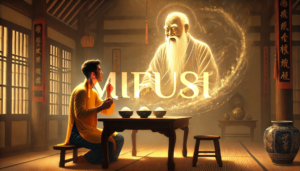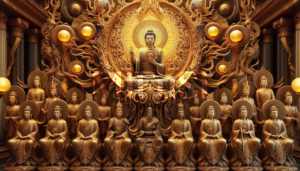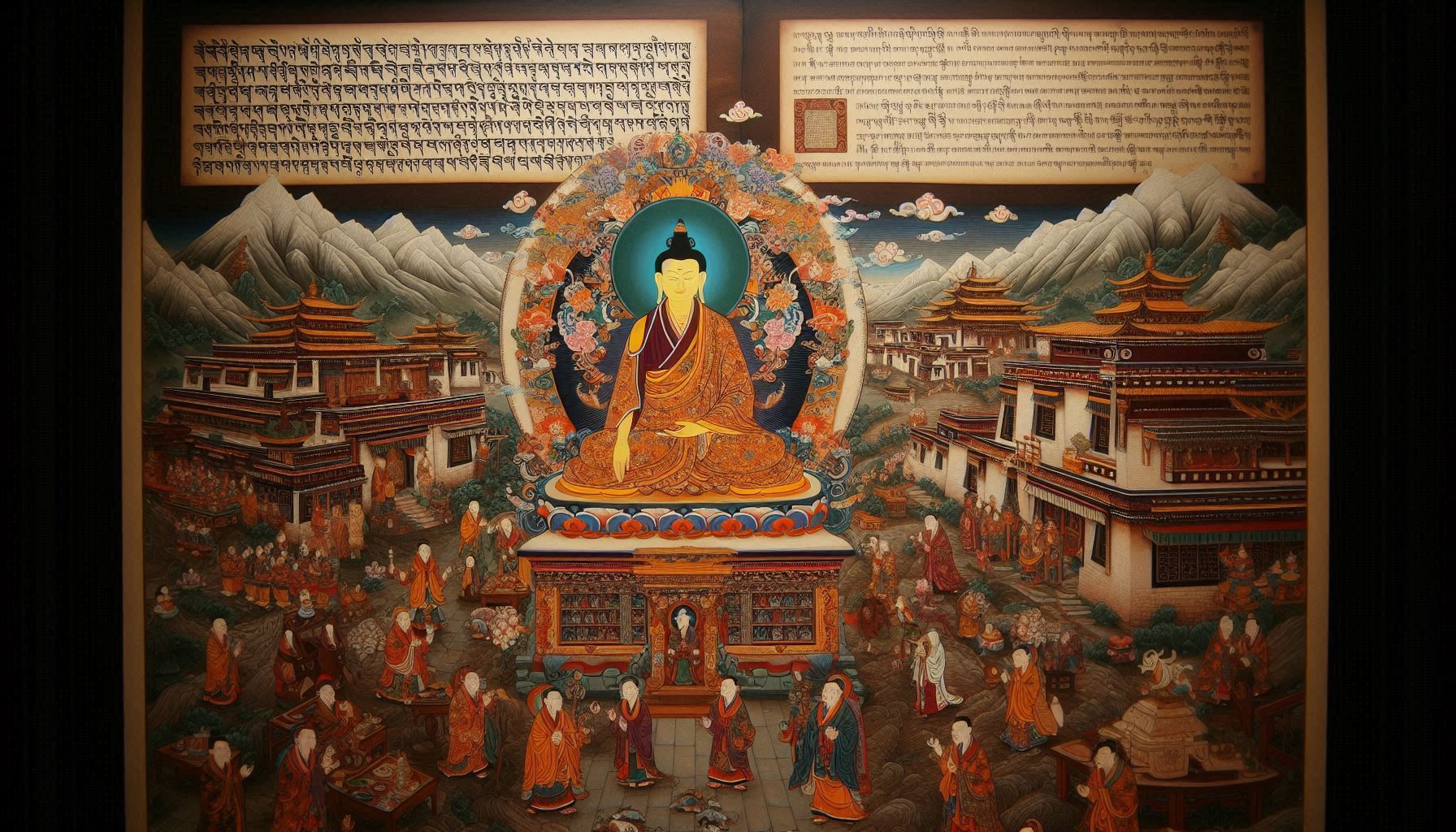The Miraculous Tree of Tsong Khapa
Linh thụ Tây Tạng; by Dianichi on Sun Nov 23, 2008 10:27 am.
The Miraculous Tree of Tsong Khapa
(Excerpt from Alexandra David-Neel’s “Magic and Mystery in Tibet”, Dover Publications, Inc., 1971)
The following is a miraculous story recorded by Alexandra D. Neel in her book “Magic and Mystery in Tibet,” published in 1921:
In the 14th and 15th centuries, there was a spiritual master named Tsong Khapa (1355-1417). He was born in Amdo, in northeastern Tibet, and founded the Yellow Hat sect (Gelug-pa). At the time of his birth, a renowned Tibetan master named Dubchenkarma Dorge prophesied that Tsong Khapa’s life would be extraordinary and advised his parents to keep his birthplace pure. Some time later, a tree grew at that location, and a hermit from the Snow Mountains came to build a temple near the tree, which is now the Kumbum Monastery.
It is said that Tsong Khapa was intelligent and insightful, having studied with many major sects of the time such as Kargyupa, Kadampa, Nyingma, and Sakyapa, and he practiced meditation in seclusion in a cave on the Snow Mountain. Observing that Buddhism in Tibet had been mixed with local religions, with monks neglecting their studies and focusing only on external forms, talismans, and spells, he decided to come down from the mountain to revive Buddhism, emphasize the precepts, and completely eliminate the commercialization of spirituality.
One day, Tsong Khapa’s mother wrote him a letter asking him to return home because he had been away for a long time. Tsong Khapa asked a disciple to bring a reply to his mother, along with a picture of the Bodhisattva Manjushri and the deity Demchok. When his mother opened his letter, a beam of light emerged and flew into the tree near his birthplace. The tree immediately began to radiate a brilliant light, and on its leaves appeared images of Bodhisattva Manjushri and the deity Demchok, along with the mantra Om Mani Padme Hum as if they were printed or painted on them. The mantra Om Mani Padme Hum also appeared on the trunk and branches of the tree. As a result, the monastery built there was named Kumbum (meaning “a hundred thousand images on the leaves”) after this miraculous event.
Two French priests of the Lazarist order confirmed in their book “Travels in Tartary, Tibet, and China” that they personally saw the entire tree, including all its leaves, clearly displaying the six-syllable mantra Om Mani Padme Hum and images of the Bodhisattva. Even the newly sprouted leaves bore these markings, leading them to conclude that they were not made by human hands.
They also noted that the Amdo area is located on a high plateau, thousands of meters above sea level, where no trees can grow. A large stupa (Chorten) was built completely enclosing the miraculous tree. If the stupa was built in the 16th century, the tree that the two priests saw in the 19th century should have been dead. However, both priests firmly asserted that they saw a lush, green tree, and they even mentioned that the number of leaves on the tree never changed; when one leaf fell, a new leaf would immediately grow in its place.
Madame D. Neel said, “I don’t know if this story is true or not, but I did observe the stupa surrounding the miraculous tree. The stupa is 50 feet tall, with a golden spire, and its doors are always kept locked, with only a few monks allowed to enter to clean. They collect the fallen leaves to distribute to pilgrims. Although I didn’t have the opportunity to examine these leaves myself, many British and French diplomats have confirmed seeing green leaves with the mantra Om Mani Padme Hum on them, and they have recorded this in their official reports. For the Tibetans, this story is not hard to believe at all.”
Commentary by Dianichi. Translated by Horangi, edited by Coiphudzu
The author of this story was Alexandra David-Neel, a French explorer and writer. She studied in Madame Blavatsky’s Theosophical Society and later went to Sikkim in India to study Buddhism, where she became a close confidante of the crown prince Sidkeong Tulku. She had met with Dalai Lama the 13th twice. She also went into a cave in Sikkim (at the time Sikkim was under an English protectorate) to study spirituality with a monk. She wrote about 30 books on Tibet and considered herself a Tibetan (from Wikipedia).
The author’s pro-Tibet stance, alongside testimonies and diplomatic documents from French priests and English diplomats, does not entirely authenticate the story of “THE MAGIC TREE.” David-Neel herself admitted to never examining any leaf from the tree, casting doubt on the tale’s veracity. Considering this, there’s a possibility that the account holds about 50% truth. The supporting documents and testimonies might have been influenced by political motives, potentially crafted by England, which had significant ties to Tibet, to serve a propagandistic purpose. This agenda aimed to bolster the Tibetan government’s efforts to propagate the faith in Tsong Khapa, who was not merely a monk but also a king, with his descendants being the Dalai Lamas.
The concept of the “Magic Tree” is not unique, as history across various cultures includes tales of kings or would-be kings leveraging supernatural stories to validate their divine right to rule or to strengthen their hold on power. For example, there are stories of names being written with honey on forest leaves. As ants consume the honey, the leaves become perforated, making the names appear as if by magic, supposedly indicating divine endorsement. Another tale involves writing a secret message or poem that reveals the identity of the “Chosen One” on a piece of cloth, which is then placed inside a fish. This fish, upon being caught by a fisherman, reveals the heavenly message to the unsuspecting public. There are also accounts of rumors about ancient tablets or stones, purportedly found deep in the wilderness, that bear the name or extol the virtues of the current or future ruler, serving as “evidence” of their rightful place in power. These stories serve similar purposes: to mystify and legitimize authority by appealing to the supernatural.
Practitioners of MatGiao (Secret Teachings) need to critically evaluate supernatural stories to discern genuine divine interventions from fabrications created by individuals or organizations seeking to exploit the gullibility of others for their own benefit. Unlike mere fabrications, when genuine miracles occur through the will of the Deities, they manifest not as singular, isolated incidents witnessed by only a select few. Instead, true miracles are demonstrated through a series of events experienced by diverse groups—typically 5 to 7 different groups—and widely observed by the general population, ensuring the broad dissemination of the Deities’ message. An illustrative example is the phenomenon in Vietnam, where psychics have been acknowledged by a wide cross-section of society, including local authorities, for finding lost tombs, thereby gaining widespread acceptance as a verifiable fact. Consequently, endorsements by a limited number of prominent individuals, regardless of their governmental or ecclesiastical status, should not be regarded as conclusive evidence of a miracle.
If a miracle genuinely originates from the Deities, it will be recognized as an undeniable truth by the majority, eliminating any disputes concerning its authenticity. The Deities themselves are responsible for presenting their message clearly and compellingly, rendering the spread of exaggerated rumors unnecessary. Consequently, should any doubt persist, regardless of its magnitude, regarding the veracity of a supposed miracle, skepticism is justified. It’s possible that the event could be an ingeniously constructed illusion, akin to those created by skilled magicians. The guiding principle is that skepticism towards a purported miracle poses no risk, whereas uncritical belief could lead to negative consequences.
Updated 3/10/24
Related Post

Chapter VI: II – Ucchusma Lectures On The Dharani Of Great Satisfaction And Wonderful Magic
II.Ucchusma Lectures On The Dharani Of Great Satisfaction And Wonderful Magic. North India, tripitaka master Ajitasena (the Invincible General) translated...

Chapter II: III – BRIEF HISTORY OF SECRET BUDDHISM IN JAPAN
Four superior Buddhist priests and others had brought the theory and practice of Buddhism to Japan. From that time, Secret...

Chapter VI: III – Ucchusma On The Supernatural Power That Stops Hundreds Of Transformations
III. Ucchusma On The Supernatural Power That Stops Hundreds Of Transformations. North India, Samana Ajitasena brought over this Sutra under...

The lesson about self-conceit
The lesson about self-conceit Bài Kiểm tra về Ngã mạn by Hoang_godalat posted on 16 December 2016 19:50. Translated by...

Nechung Oracle – Freedom in Exile
Dear Mystics Members, Explore an excerpt from the Dalai Lama's "Freedom in Exile." Delve into Chapter 12, "Of Magic and...

Old-Guru Self Introduction
Old-Guru Self Introduction All stories from Old Guru #1 through #15 were posted on the thegioivohinh forum while vutruhuyenbi is...

THE SUPERIORITY COMPLEX AND LACK OF TOLERANCE IN A VENERABLE
translated by Dianichi We would like to tell the story of a venerable monk known as the Living Buddha, who...

Chapter VI: IV – The Dharani Of Great Satisfaction, Of Fearlessness And Compassion Sutra From Thousand Heads, Thousand Arms Avalokitesvara Bodhisattva
IV. The Dharani Of Great Satisfaction, Of Fearlessness And Compassion Sutra From Thousand Heads, Thousand Arms Avalokitesvara Bodhisattva. In the...
